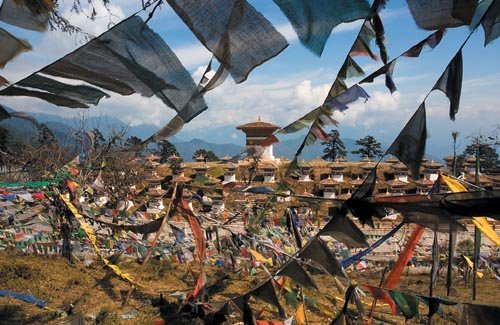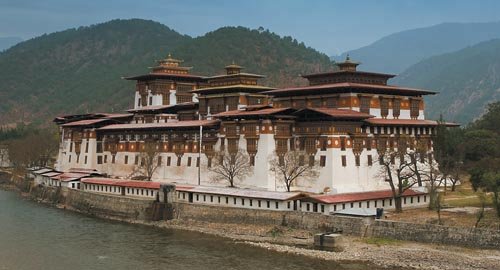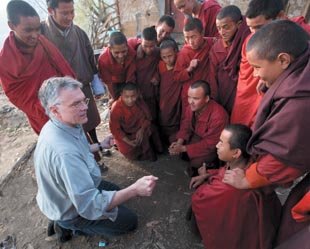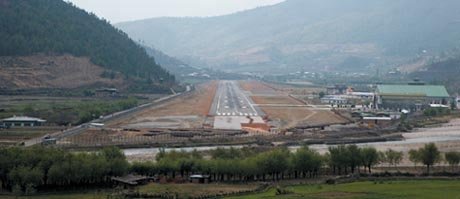See Beyond the Frame
| It's not only what you see in the viewfinder that makes a good photographic image. Often, you need to see beyond the single frame and look for the larger story; you need to perceive how the subject fits into the overall environment. Sometimes a story is better told in more than one image, or from a unique perspective that captures what you as the photographer experienced, whether trekking up a mountain path or viewing a scene through fluttering prayer flags. Think Slide ShowSometimes, it takes more than a single image to tell a storyespecially when you want to put together a slide show, Web gallery, or PDF presentation. In those situations, and with those thoughts in mind, it's good to take a set or series of pictures. To tell the story of archery in Bhutan, the national sport played throughout the kingdom, I took many pictures. These are two of my favorites: a close-up of an archer dressed in a gho (traditional dress), and a picture of an archer standing (unbelievably) right next to a target (Figures 5.10 and 5.11). The really unbelievable part is that the archers walk into position, aim, and shoot in a matter of secondsand hit the far-off target more often than you might imaginewithout hitting any of the other archers! Figure 5-10.Tech info: Canon EOS 1D Mark II, Canon 70-200mm IS lens @ 200mm. Exposure: 1/125 sec. @ f/2.8. ISO 400. Figure 5-11.Tech info: Canon EOS 1D Mark II, Canon 70-200mm IS lens @ 200mm. Exposure: 1/125 sec. @ f/4.5. ISO 400. Create a Sense of DepthYou see the world in three dimensions: height, width, and depth. Cameras see only two: height and width. One way to create a sense of depth is to include a foreground subject. On the next page, I framed the stupas (religious structures) at Dochu La mountain pass with hundreds of prayer flags (Figure 5.12). Figure 5-12.Tech info: Canon EOS 1Ds Mark II, Canon 17-40mm lens @ 17mm. Exposure: 1/125 sec. @ f/11. ISO 400. By using a wide-angle zoom lens and a small f-stop setting on the lens, and by focusing one-third into the scene, I was able to capture all the elements in the frame in sharp focusjust the way I saw it with my eyes. Be on the LookoutIf you've ever been to a theme park or other tourist attraction, you've seen photo spotslocations suggested for good pictures. You may be tempted to pass them up, believing them to be artificial or mundane. Don't. When I travel, I ask my guides for spots, often lookouts, where tourists take pictures. I shoot photographs, like this picture of the Punakha Dzong, at these spots to round out my presentations (Figure 5.13). Don't overlook these lookouts. You can get some nice shots from them. Figure 5-13.Tech info: Canon EOS 1Ds Mark II, Canon 17-40mm lens @ 17mm. Exposure: 1/60 sec. @ f/8. ISO 100. Get Lucky!Many people tell me how lucky I am to travel to places like Bhutan and get pictures like the one of Tiger's Nest Temple on the next page (Figure 5.14). Yes, I'm very lucky. But I've found that the harder I work, the luckier I become. Figure 5-14.Tech info: Canon EOS 1D Mark II, Canon 70-200mm IS lens @ 150mm. Exposure: 1/125 sec. @ f/5.6. ISO 400. Your "luck" for taking a picture like this would include making a hike from about 7,500 to 10,000 feet over a winding, rocky, slippery path. Even though I'm in good shape, this was the hardest hike I've ever been on. And, of course, the luck that took me to Bhutan came after years of hard work. Have Fun!Ask yourself this question: "What does my photography mean to me?" Now close your eyes and think carefully about your answer for a few minutes, and then come back. I do that exercise at my workshops. It's interesting, because there are so many different answers. For me, photography is fun, plain and simple. I do work hard, but it's work I really enjoy. The reward of getting a good shota keeperis tremendous. In this picture, I'm having a blast (Figure 5.15), showing the monks one of my magic tricks. In doing so, I showed them that I'm honestly interested in them, not just interested in taking their pictures. Figure 5-15.Tech info: Canon EOS 1Ds Mark II, Canon 17-40mm lens @ 17mm. Exposure: 1/125 sec. @ f/11. ISO 400. Photo: Susan Sammon There is a great expression: If you love what you do, you never have to work a day in your life. Have fun with your photography, and don't let all the technical aspects of picture-taking get in the way. Fasten Your SeatbeltsThe last photograph in this book is one of the last I took on our Bhutan adventure (Figure 5.16). It's not my best image from the trip, but it tells an interesting story. Figure 5-16.Tech info: Canon EOS 1Ds Mark II, Canon 17-40mm lens @ 40mm. Exposure: 1/125 sec. @ f/11. ISO 200. Landing at the Paro airport, the only airport in Bhutan, is, well…unique. It's one of the most unusual landings in the civilized world. The Royal Druk Airbus has a distinctive challenge: It has to weave its way over and around the mountains, turning left and right and arcing up and down, to make the landing on a runway that ends relatively close to the face of a mountain. It's like a rollercoaster in the air! After one bank, when I looked out the window, I swore the mountain was only 300 feet away from the tip of the wing. Susan and I and our fellow passengers were all laughing at what we saw to cover up our nervousness. We were all happy when the rollercoaster of a ride in the sky ended and the plane finally landed. And just for the record, the take-off was just as thrilling. |
EAN: 2147483647
Pages: 72






